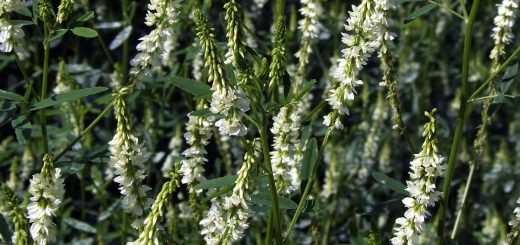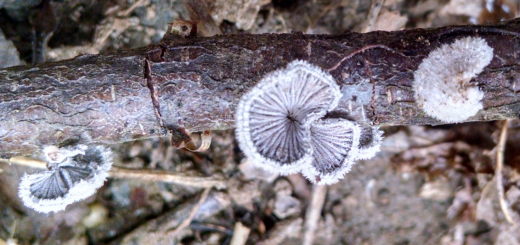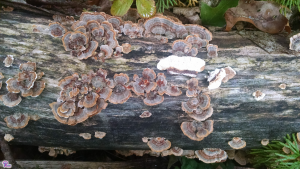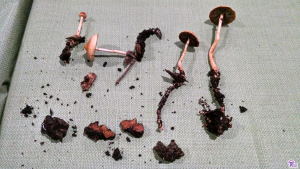#128: Anastamosis
Anastomosis is the process by which fungal cells fuse together. This process is very important for filamentous fungi because it allows them to form networks and is a key part to sexual reproduction.
When a spore germinates, it sends out a hypha (a cylindrical thread of fungal cells). This hypha branches and the new branch grows outward to avoid the other branch. Eventually, the hyphae are growing outward in a full circle around the original spore. To maintain this type of growth, the hyphal tips have to be repelled by one another. Upon nearing another hypha, the tip will change direction or stop growing. This ensures that new areas of substrate are efficiently colonized.
In anastomosis, hyphae are attracted to one another instead of repulsed. It is not clear what triggers this change in behavior, but it seems to be related to maturity of the mycelium (web of hyphae) and to the density of hyphae. Anastomosis predominantly occurs in older parts of the mycelium, which tend to have hyphae that are close together and have fewer available nutrients (because the fungus has already consumed most of those resources). In these areas, hyphae anastomose when growing close together. This results in the formation of links between different hyphae, thus creating a true reticulating network. Such a network has multiple links between its different sections, like a net or a web. This allows the fungus to transfer resources and communication molecules from one part of the mycelium to any other part, which lets the mycelium to act as a single organism.
Anastomosis sets fungi apart from most other forms of life on earth. Their ability to fuse with each other is unparalleled in plants, animals, and nearly all other kingdoms. Consider this scenario: you have a fungus growing on an agar dish. This fungus is clearly a single individual. You cut the fungus in half and put each half in a new dish. Now you have two individuals, right? You then put the two fungi back into the same dish. They grow towards each other and – through anastomosis – fuse to become one organism again. So how many individuals did you really have? There is no good way to answer this question in nature.
As a real-life example of this, mycologists claim – based on DNA – that the world’s largest organism is a fungus in Oregon. However, there is no way to prove that every part of that organism is connected. Anastomosis makes it clear that that, given the opportunity, any part of that organism would fuse with any other part. So what about those factories turning out millions of button mushrooms for grocery stores, pizzas, etc.? Although the mushrooms grow in boxes that are clearly separate from one another, they would readily fuse if that were an option. This makes it very difficult to define what an individual is within the fungal kingdom. Depending on your definition, those little mushrooms you put on your salad the other day could have been part of an astoundingly large individual.
There are some plants, such as Quaking Aspen, that form large clonal (genetically identical) groups similar to those formed by fungi. This is achieved by sending up new shoots from the root system, which then grow more roots. However, it is not clear to me whether or not plants can form true reticulating networks in this manner. If they cannot, then cutting one of these clonal groups in half would result in two individuals that would remain two individuals.
Anastomosis has not received the attention it deserves. Mycologists have not yet worked out the molecular processes involved, so anastomosis is still not well understood. They have, however, determined the behavioral sequence of anastomosis. The process of fusing two hyphae has five steps:
- Recognition: All fungi secrete low levels of hormones into their environment. These hormones are a way of telling nearby hyphae, “Here I am!” Two hyphae will not react to each other unless they are close enough to detect the hormones of the other hypha.
- Attraction: When an approaching hypha encounters these hormones, it has three options: repulsion, attraction, and defense. As discussed above, hyphae in young areas of the mycelium will likely be repulsed, while hyphae in old areas of the mycelium will likely be attracted. If the hypha recognizes the hormones as being very different from itself, it may secrete proteins to defend its territory from the other fungus. The only one of these reactions that will result in anastomosis is attraction. If the two hyphae are attracted to each other, one or both of the hyphae will begin growing toward the other.
- Fusion: Once the hyphae are in contact with each other, they secrete enzymes to break down their cell walls at the point of contact. The cell wall must then be restructured to support the new bridge that is forming. Finally, the plasma membrane must be fused so that the cytoplasm of each cell can meet.
- Compatibility Reaction: Once the cytoplasm merges, the two hyphae can exchange nuclei, organelles, and signaling molecules. To ensure that this happens only between hyphae of the same organism or of closely related organisms (in the same species or sub-species), there are a variety of genes that must be identical. In model organisms, there are between 7 and 11 of these “vegetative incompatibility” genes, with most having about 10. If the two fused hyphae have a different version of any of these genes, one or both of the cells directly involved in anastomosis kill themselves. This process of cell death is programmed into the cells’ DNA and minimizes the risk involved with anastomosis.
- Next Steps: What happens after anastomosis depends on the fungus’s life cycle. If the two hyphae involved are part of the same individual, communication between separate parts of the fungus is initiated but nothing else changes. Things get more complicated if the two hyphae are from different individuals. Possible results of this interaction are described below:
- If each individual has a haploid nucleus (one copy of each chromosome), the different nucleus may be copied and sent to the rest of the mycelium. As a result, the two genetically distinct individuals can become one genetically identical individual.
- Alternatively, the fused cell which now contains two different haploid nuclei may give rise to a new hypha, which results in a new mycelium propagating out from that center while the two original mycelia remain unchanged.
- Another option is for the two different nuclei to remain in the same cell without moving or growing in any direction.
- After anastomosis, the nuclei will also be assessed for mating type compatibility. Mating type compatibility is determined by mating type genes. To be compatible, the individuals must have different versions of each mating type gene. If the two fungi are compatible, sexual reproduction will occur in the proper manner for that species. It is important to point out that two fungi that are sexually compatible but vegetatively incompatible will not be able to mate successfully. Anastomosis must always happen prior to sexual reproduction, so successful reproduction will only occur if the individuals are both vegetatively and sexually compatible.
As mentioned above, anastomosis carries some risks. When the cytoplasm of one fungus fuses with that of another, all kinds of things get transferred. Some of these things may be harmful and vegetative incompatibility genes are designed to minimize the transfer of harmful materials. Things that may harm a fungus include: parasitic organelles (a good example in humans is mitochondrial disease), viruses, and plasmids. Viruses that infect fungi are remarkably similar to those that infect animals, but they can be spread only through anastomosis. Plasmids are small loops of DNA that are not part of the fungus’s genome. These behave a lot like viruses and should be avoided. It is also risky for two fungi to fuse their cytoplasm because one fungus could use that bridge to steal the other’s resources.
Anastomosis is the process of fusing two hyphae together, so yeast – which are single, roughly spherical cells – cannot carry out anastomosis. However, the process of conjugation (fusion for sexual reproduction) in yeast is very similar on a molecular level. Since yeast evolved from filamentous (hyphae-producing) ancestors, this is not surprising. Rather than create a new molecular system to carry out conjugation, evolution likely repurposed the existing anastomosis machinery.
See Further:
http://archive.bio.ed.ac.uk/jdeacon/FungalBiology/chap3a.htm (pictures only)
https://books.google.com/books?id=eY7wBwAAQBAJ&printsec=frontcover#v=onepage&q=anastomosis&f=false
https://en.wikipedia.org/wiki/Anastomosis#Mycology
http://bugs.bio.usyd.edu.au/learning/resources/Mycology/Reprodn_Dispersal/compatibility.shtml









![#011: Characteristics of Kingdom Fungi [Archived]](https://www.fungusfactfriday.com/wp-content/themes/hueman/assets/front/img/thumb-small-empty.png)



3 Responses
[…] meet, a series of chemical interactions determines whether they can fuse with one another (see FFF#128). If the chemicals do not match up correctly, the cells at the contact point die and the fungi […]
[…] they are typically black and a few millimeters thick5 and branch and fuse just like hyphae do (see FFF#128), but on a much larger scale. The large size of the rhizomorphs makes the mycelium more efficient […]
[…] their cells and enter the dikaryon stage (for more on this process – called anastomosis – see FFF#128). In this stage, each fungal cell has two nuclei – one with chromosomes from one parent and one […]